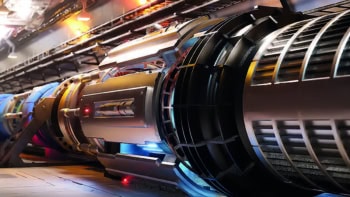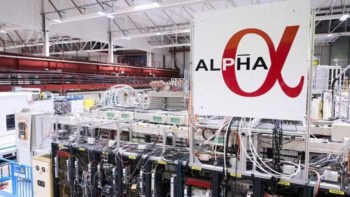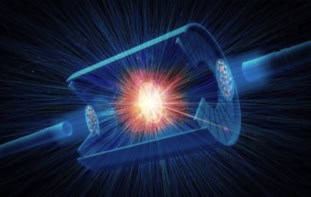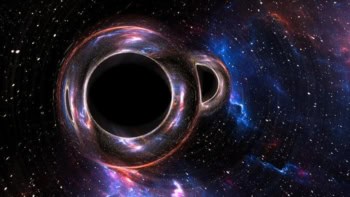Results presented at the International Europhysics Conference on High Energy Physics in mid-July provide strong hints that the Higgs boson, one of the holy grails of particle physics, is lurking just around the corner. Over 500 physicists gathered in Tampere, Finland, armed with the latest data and hot on the trail of this elusive particle, the interactions of which are thought to be responsible for giving particles their mass. The Higgs boson is the only unobserved piece in the jigsaw puzzle of elementary particles in the Standard Model. And it now appears to be within tantalizing reach of experiments that will take place over the next few years.
Particle physicists maintain a curiously “Jekyll and Hyde” approach to the Standard Model. On one hand it is an elegant theoretical framework, based on fundamental symmetry properties of nature, which encapsulates our knowledge of elementary-particle interactions via the electromagnetic, weak and strong forces. The Standard Model is hence a cherished icon that has passed every test of comparison with experimental data with flying colours.
On the other hand, the so-called Higgs mechanism was introduced in an ad hoc fashion. This mechanism “breaks” the symmetry between the electromagnetic and weak forces, and leads to the carriers of the weak-force interactions – the W and Z bosons – acquiring mass.
The Standard Model is hence incomplete, and perhaps there is a deeper underlying symmetry principle in nature that, if broken, would naturally give rise to this effect.
One currently favoured idea is the notion of “supersymmetry” – affectionately known as SUSY. This is a symmetry between the interaction properties of elementary fermions (particles with half-integer spin) and bosons (particles with integer spin). When supersymmetry is broken, it gives rise to the particles of the Standard Model as we know them today. The theory also predicts a new set of massive particles containing a fermion partner for each known boson, and vice versa. It is a standing joke that the best evidence for SUSY is that we have already discovered half of the expected particles!
New particles are hence eagerly sought in experiments throughout the world. As reported at Tampere, despite vigorous searches at the world’s particle-physics laboratories, there is no direct evidence for these particles yet. However, the experimental sensitivity continues to improve and eats into the mass range that the new particles are allowed to have in SUSY (and other) theories.
In the absence of direct evidence for new particles, attention has focused on precision tests of the Standard Model itself, in the hope of observing some subtle discrepancy with the data that may provide telltale evidence of new physics.
Many properties of the Z boson have been measured in electron-positron annihilation experiments at the LEP collider at CERN, near Geneva, and at the Stanford Linear Collider (SLC) in California. Some of these properties have been measured with an accuracy of a few parts per thousand and compared with predictions from the Standard Model. Although most of the reported measurements are in good agreement, there are a few that differ at the level of roughly two standard deviations. One of these is the cross-section for producing the Z boson. Another relates to the strength of the coupling between the Z boson and the massive bottom quark. And a third is associated with the “mixing angle”, qW, which relates the electromagnetic charge, e, to the weak charge, g, via e = gsinqW.
Intriguing though these differences are, given the fact that a total of 16 properties of the Z boson have been measured it is natural that several will deviate from their predicted values by a couple of standard deviations. It would require much more significant deviations to shake the foundations of the Standard Model.
In proton-antiproton scattering experiments at the Tevatron collider at Fermilab in the US, the W bosons and the super-massive top quark (175 times heavier than the proton) have been studied in detail. In particular their masses have been measured to precisions of 0.1% and 3%, respectively. The mass of the W boson has also been measured with similar precision at LEP.
These masses are very interesting because in order to predict them in the Standard Model we need to know the mass of the yet-undiscovered Higgs boson. In fact, all the predictions from the Standard Model depend to some extent on the Higgs mass, although the degree of sensitivity is different for different physical quantities.
This apparent weakness can be turned to our advantage by confronting the Standard Model with all of the data – 20 measured quantities in total – and determining the Higgs mass that fits best (). The latest estimate, presented at Tampere, gives a Higgs mass of 92-45+78 GeV. Although the errors are rather large, this value is within the reach of several current experiments. For example, LEP is now producing electron-positron collisions with an energy of 200 GeV and experiments there should be able to detect the Higgs mass within the next two years if its mass is less than about 108 GeV.
Meanwhile, the Tevatron has been upgraded to provide more than ten times as many proton-antiproton collisions per unit time (the “luminosity”) compared with the last run carried out in 1996. Data-taking will commence in 2000, and within a few years the CDF and D0 experiments expect to be able to detect the Higgs boson if its mass is less than 120 GeV. Further improvements in luminosity would increase the mass-reach yet further, perhaps to 180 GeV by 2005.
Exciting though these near-term discovery prospects are, if nature is unkind then the Higgs mass could be great enough to elude both LEP and the Tevatron. However, the CERN Large Hadron Collider (LHC), due to start operation in 2005, will smash protons together with an energy seven times higher than that at the Tevatron. The LHC will be able to detect the Higgs even if it is as massive as 1000 GeV, which is well above the region suggested by the current data.
At the conference it was also reported that plans are advancing in Europe, the US and Japan for a higher-energy, linear electron-positron collider to follow on from the pioneering SLC at Stanford. Such an accelerator would be the ultimate Higgs “factory”, producing tens of thousands of Higgs particles a year. This would allow incisive precision measurements of the Higgs, and any other new particles, perhaps as early as 2010.
Although colliding elementary particles together at the highest possible energies is a good way to uncover new phenomena, experiments performed at lower energies can also be sensitive to important new effects. Good examples were provided by the latest measurements based on the decays of millions of K mesons. The NA48 experiment at CERN and the KTeV experiment at Fermilab have firmly established a tiny asymmetry, at the level of 1 part in 1000, which indicates a violation of the charge-parity (CP) symmetry operation. Such “CP violation” is allowed within the Standard Model at the level of a few parts in 10 000, although a precise calculation of the exact amount is tricky.
Interestingly, the average of the new measurements is roughly four times larger than expected from some calculations. This will stimulate renewed efforts to firm up the theoretical predictions to see if such a “large” effect can be accommodated within the Standard Model, or whether the data provide evidence for new physics.
CP violation will also be pursued in the next decade by collecting and studying the decays of billions of B mesons at the new generation of “B factories.” The BaBar experiment in the US and the Belle experiment in Japan have successfully been turned on. They will soon be joined by the CLEO experiment in the US, and all three collaborations expect to show results at future conferences.
One of last year’s major developments was the announcement by the SuperK collaboration in Japan of evidence for a deficit of muon neutrinos in particle showers produced by cosmic rays striking the Earth’s atmosphere. The SuperK experiment also showed an “up-down asymmetry”, with more muon neutrinos detected entering the experiment from above (“up”) than from below (“down”). By contrast no up-down asymmetry was observed for electron neutrinos. This provided indirect evidence for the “oscillation” of muon neutrinos into a type of neutrino other than the electron neutrino. Such “flavour oscillations” are already known for K mesons and B mesons, and they are a remarkable manifestation of quantum mechanical behaviour.
At Tampere, the SuperK collaboration reported its up-down asymmetry measurement is now an impressive eight standard-deviations effect. The most likely explanation of the SuperK results and other data is that the muon neutrinos can oscillate into tau neutrinos and vice versa.
There is nothing in the Standard Model that forbids neutrino oscillations, but their existence implies that neutrinos have non-zero mass, whereas their mass is usually set to zero in the Standard Model. The measured neutrino oscillations imply that one species has a mass of at least ~ 0.05 eV. As neutrinos are so prevalent throughout the universe, massive neutrinos could provide an important component of “dark” matter. Their mass is, literally, of cosmic significance.
Several new neutrino experiments have just started taking data, and others are in the construction and planning phases, so the study of neutrino oscillations promises to be lively for some time to come.
Back on Earth, a group from the University of Mainz in Germany presented a preliminary, and very precise, direct experimental limit on the mass of the electron neutrino. The Mainz group studied the high-energy tail of the ß-particle energy spectrum in tritium radioactive decay with impressive accuracy. They determined that the mass of the electron neutrino is less than 2.3 eV at a 95% confidence level.
Apart from these selected highlights, an enormous number of beautiful results – both experimental and theoretical – were presented in several hundred talks. Undaunted, the plenary-session speakers summarized admirably the wealth of new information, much of it extremely precise, on all aspects of particle physics. The combination of the magnificent Tampere Hall location and the careful planning of the organizing committee ensured an enjoyable and successful conference.



